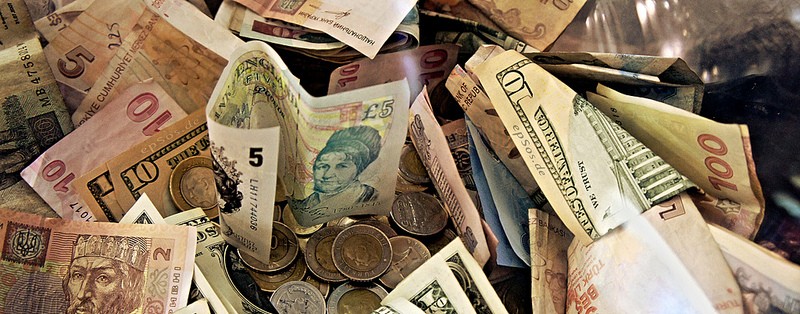The dollar may be the world’s main global currency, but it does not serve in that capacity alone. The euro has served as an alternative since its introduction in 1999, when it took the place of the Deutschemark and the other European currencies that had also been used for that purpose. Will the renminbi become the next viable alternative?
A new volume, How Global Currencies Work: Past, Present and Future by Barry Eichengreen of the University of California-Berkeley and Arnaud Mehl and Livia Chiţu of the European Central Bank examines the record of the use of national currencies outside their borders. The authors point out that regimes of multiple global currencies have been the norm rather than an exception. Central banks held reserves in German marks and French francs as well as British sterling during the period of British hegemony, while the dollar became an alternative to sterling in the 1920s. The authors foresee an increased use of China’s renminbi and “..a future in which several national currencies will serve as units of account, means of payments, and stores of value for transactions across borders.”
Camilo E. Tovar and Tania Mohd Nor of the IMF examine the use of the reminbi as a global currency in a IMF working paper, “Reserve Currency Blocs: A Changing International Monetary System.” They claim that the international monetary system has transitioned for a bi-polar one based on the dollar and the euro to a tri-polar system that also includes the renminbi. They provide estimates of a dollar bloc equal in value to 40% of global GDP that is complemented by a renminbi bloc valued at 30% of global GDP and a euro bloc worth 20% of world output. The renminbi bloc, however, is not primarily Asian, but rather dominated by the BRICS countries (Brazil, Russia, India, China, South Africa). This suggests that its increased use may be due to geopolitical reasons rather than widespread regional use.
If relative size is a driving factor in the adoption of a currency for international transactions, then an increasing role for the renminbi is inevitable. But the dollar will continue to be the principal currency for many years to come. Ethan Ilzetzki of the London School of Economics, Carmen Reinhart of Harvard’s Kennedy School and Kenneth Rogoff of Harvard examine the predominance of the dollar in a NBER working paper, “Exchange Arrangements Entering the 21st Century: Which Anchor Will Hold?” They show that the dollar is far ahead of other currencies in terms of trade invoicing , foreign exchange trading, and most other measures.
The U.S. also holds a dominant role in international financial flows. Sarah Bauerle Danzman and W. Kindred Winecoff of Indiana University Bloomington have written about the reasons for what they call U.S. “financial hegemony” (see also their paper with Thomas Oatley of the University of North Carolina-Chapel Hill and Andrew Penncok of the University of Virginia). They point to the central role of the U.S. financial system in the network of international financial relationships. They claim that the financial crisis of 2008-09 actually reinforced the pivotal position of the U.S., in part due to the policies undertaken by U.S. policymakers at that time to stabilize financial markets and institutions. This included the provision by the Federal Reserve of swap lines to foreign central banks in countries where domestic banks had borrowed dollars to invest in U.S. mortgage-backed securities. (Andrew Tooze provides an account of the Federal Reserve’s activities during the crisis.)
The central position of the U.S., moreover, evolved over time, and reflects a number of attributes of the U.S. economy and its governance. Andrew Sobel of Washington University examined the features that support economic hegemony in Birth of Hegemony. He cites Charles Kindleberger’s claim of the need for national leadership in order to forestall or at least offset international downturns, such as occurred during the depression (see The World in Depression 1929-1939). Kindleberger specifically referred to the need for international liquidity and the coordination of macroeconomic policies by a nation exercising economic leadership.
Sobel, drawing upon the history of the Netherlands, Great Britain and the U.S., maintains that the countries that have provided these collective goods have possessed public and private arrangements that allowed them to provide such leadership. The former include adherence to the rule of law, a fair tax system and effective public debt markets. Among the private attributes are large and liquid capital markets and openness to foreign capital flows. Sobel shows that these features evolved in the historical cases he examines in response to national developments that did not occur in other countries that might have been alternative financial hegemons (such as France).
Will a new dominant financial hegemon appear to take the place of the U.S.? It is difficult to see the European Union or China assuming that role in the short- or medium-term. European leaders are dealing with disagreements over the nature of their union and the discontent of their voters, while China is establishing its own path. (See Milanovic on this topic.) U.S. financial institutions are dedicated to preserving their interests, and not likely to surrender their predominance. It would take a major shock, therefore, to current arrangements to upend the existing network of financial relationships. But we now live in a world where such things could happen.
